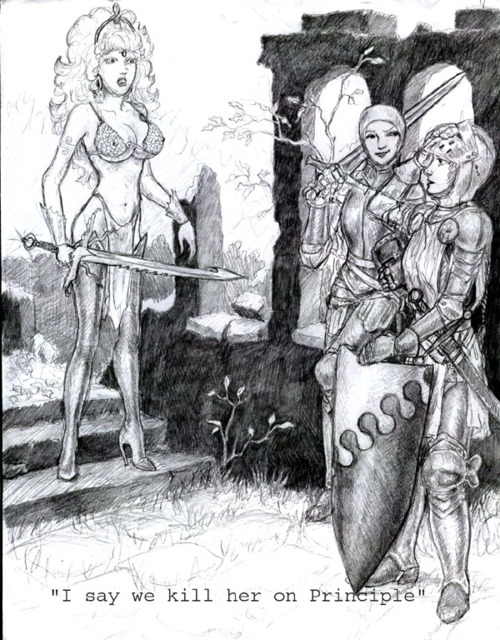(Strictly, this isn’t about my worldbuilding, but about BioWare’s worldbuilding for their Dragon Age series. Nonetheless, I think it covers some important territory about worldbuilding in general, and so, it goes in the Relevant category.)
So, having pleased some people with my post on Dragon Age and sexuality [elsewhere], I’m about to displease everyone with a post on Dragon Age and race. So it goes.
Specifically, I’m going to address the issue of the purported lack of “people of color” in the settings of the first two games of the series from a worldbuilding perspective.
Now, this is a map of Thedas:

As you can see, it’s big. It’s also in the southern hemisphere of its world, so things are reversed, but that doesn’t change the scale. Ferelden, down at bottom right, is right up at the “top” of the temperate zone. (If you look carefully, you can see that the part of the Amaranthine Ocean next to it is labeled “The Frozen Seas”.) South of it are the Korcari Wilds, which are essentially tundra, and the pole.
Meanwhile, up at the top right is Par Vollen, the Qunari homeland – well, colony. Par Vollen, canonically, is just about on the equator, and has a climate to match. (The patch of green at top left is “The Donarks”, and is an actual jungle.)
Alas, neither this map nor the version in the Dragon Age RPG player’s guide comes with a scale bar, but we are told that Thedas is roughly the size of Europe, which would make sense given the climatic variation we’re told about in the lore. Which would make the distance between, say, Denerim and Qunandar in Par Vollen something similar to the distance between London, England and Casablanca, Morocco.
So, let’s talk phenotypes. It is generally accepted that, before fast transit was as readily available as it is today, you found the pale-skinned people up in the dim, cold latitudes and the dark-skinned people down in the sunny, hot latitudes simply because of the evolutionary advantages of each state to its locale. Pale-skinned people on limited diets Up North don’t suffer from vitamin D deficiency, which their darker-skinned cousins would. Meanwhile, the dark-skinned people in the tropics can work outside all day without being on the fast track to melanoma, something that their paler relatives would have to worry about a lot more.
Does Thedas have fast transit? Well, no. You can walk, you can ride, or you can take ship. And by ship, I mean sailing ship, since not even the relatively technologically advanced Qunari have steamships, and not particularly advanced sailing ships, either – while the Qunari crossed the Amaranthine Ocean to get to Par Vollen, so far as we know, and even then:
For their part, the Qunari treat Par Vollen as their homeland. Contact with their original homeland was intermittent at best across the turbulent Northern Ocean before it finally ceased altogether two centuries ago. Several ships have been sent home to restore contact, but they have not returned. The Qunari are here to remain and have accepted this.
And so far as we know, the Thedosians don’t travel beyond the continent we know, shown on the map. No-one’s yet discovered whatever analog of America they may be.
And magic is not an answer to this. (Probably a good thing, since those fantasy universes which have convenient mass teleporting rarely examine all the implications that it should have.) But in any case, on this point, the lore is clear:
No one, for instance, has found any means of traveling-either over great distances or small ones-beyond putting one foot in front of the other. The immutable nature of the physical world prevents this. So no, you may not simply pop over to Minrathous to borrow a cup of sugar, nor may you magic the essay you “forgot” in the apprentice dormitory to your desk. You will simply have to be prepared.
Now, it’s not like there weren’t some people of non-autochthonous races to be found when actual Europe was at this stage of development. Obvious example: the Varangians, who wereeverywhere in their heyday, but, well, they were Vikings, who were like that. There’s a marvellous book I keep meaning to track down written by a Muslim merchant who travelled the same journey in the other direction, for that matter. And certainly, there have always been a few travellers, for adventure or profit or war, who crossed these large distances.
But what there wasn’t, to any signfificant degree, was anything recognizable as a “mixed” or “diverse” society by what we might consider modern standards, simply because travel was so slow, and so expensive, that it was the exclusive preserve of the vagabond and the wealthy elite, neither of whom made up any large percentage of society. (Evidence for expensive: look at the Fereldan refugees in Kirkwall. Just crossing that relatively minor part of the map, the Waking Sea, with nothing to do with their savings and possessions but spend them on escaping the Blight, are all flat broke. And ten years later, most of them still can’t afford to go back. Travel is anything but affordable for “regular people” at this level of technological and economic development.)
What you would see, wandering around a city at the time, is a crowd made up almost entirely of the predominant race, with maybe – in cosmopolitan cities – a few stand-outs from the crowd.
…which is what you see, both in Denerim, in the original Dragon Age, and in Kirkwall (also far to the south) in Dragon Age II. (In which, it is interesting to note, that the two principal dark-skinned characters I call to mind, Isabela and the merchant Hubert, are both Rivaini. Rivain, you may note from the map, is that peninsula to top-right, right under Par Vollen, and hence pretty equatorial. The Antivans you meet, while not as dark as the Rivaini, are still darker-complexioned than their southern cousins. (A possible exception here would be Zevran, who isn’t particularly dark, but what we don’t know about elvish physiognomy is everything.)
In short, just about everything we see about NPC racial characteristics is in tune with the geography.
Aha, I hear you cry. But just because those are the social arrangements of the real world is no reason to reproduce them in fantasy! They could have written it the other way if they reallywanted to.
Well, no, they couldn’t. Trust me, I’m a worldbuilder. And we are, not to put too fine a point on it, seriously concerned with plausibility. I’m relatively lucky in this perspective – I write in a world of non-human species, which gives you some more – not a lot more, but some – flexibility that the builders of humanocentric species don’t get, because we all know how humans work. Intimately.
What are you going to do? Introduce faster travel (in which case you need to detail what kind, and how, which have consequences), or mass teleporting? That has a million other consequences which would completely change both the feel of the setting, and the facts of the setting. In fact, I very much doubt you could write a setting using these themes and have fast travel.
Extend the length of history so that people had time to mingle (and invent some historical events to drive it, quite possible) on a mass scale even with slow travel? Well, fine, except then you need to come up with a plausible explanation for the Medieval Stasis. And, honestly, this is a trope that is nearly never done well, if anyone bothers to explain it at all.
Or decide that these humans, physiologically, are completely different from the regular kind and that thus phenotypic adaptations to different levels of solar radiation are equally distributed, never mind what the sun’s actually doing? (Even if you flattened the entire planet to even out the solar radiation – with monumental consequences for geography, biomes, weather patterns, etc., etc., you’d just get monochromatism, not a mixed distribution.)
In each case, that loud twanging noise you just heard was the reader’s, player’s, person-paying-attention’s suspension of disbelief just snapping like a twig, because when you do these things,your world does not make sense.
Now, I’m impressed with the worldbuilding that went into Thedas; I think Bioware’s creative team did an excellent job on putting it together and making it fit. But I’m not unsympathetic either to the desire for protagonists “of color”, or indeed, of more NPCs likewise – just, I ask, make this happen in a way that does make sense. Set an episode of the story up in the equatorial north, in Antiva, or Rivain, or the northern part of Tevinter. Revisit the notion in the original Dragon Age of multiple origin stories, and let us create a protagonist of Rivaini descent – and, please, show that by something other than just a skin-color choice – anywhere.
But don’t break the world by sticking people in where they logically wouldn’t be just for the sake of it, or having protagonists whose history and appearance don’t fit together, with or without gratuitous retcons. That’s pandering, and people can tell that it’s pandering, and I – for one – would rather have it done right some of the time, where it fits the world and the story, than done badly all of the time.






